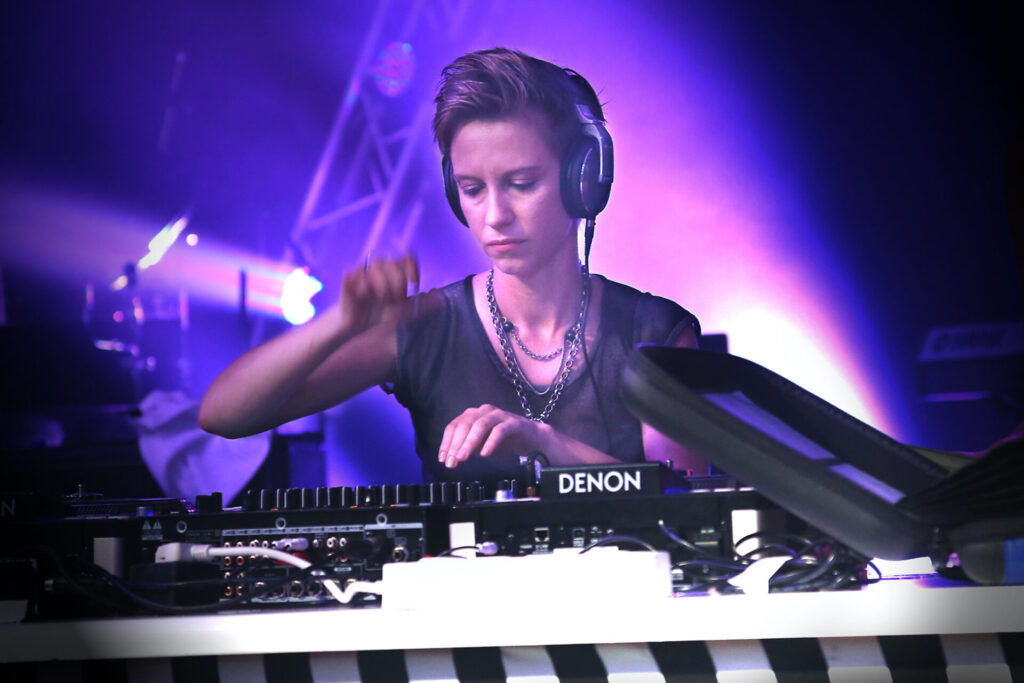+ Our brand new course with The Dillinger Escape Plan’s Ben Weinman teaches how to make a living in music without making sacrifices. Check out The Business of Uncompromising Art, out now exclusively on Soundfly.
Love it or hate it, hardcore punk (simply: hardcore) is undoubtedly one of the most influential genres of the past 50 years. When it first emerged in the early 1980s, many listeners and critics dismissed it as mere noise and sheer aggression. Despite this, loyal fanbases across the world and dedicated artists nurtured a scene that continues to push the genre forward.
Values that were pioneered and preserved by the hardcore scene have since bled through the music industry at large, and that’s a very good thing. Whenever you see a band making a living off DIY aesthetics and commitments, holding the mic towards the crowd for fans to sing into, or playing so hard that their blood and sweat stain the stage forever, that’s the legacy of hardcore punk manifesting itself.
So here’s a list of some of the most widely-recognized pioneers of hardcore punk (mostly. We’re sorry if your favorite band got left off this list — obviously, this list could be hundreds long so we’re calling it “a brief” crash course in the subject.
And speaking of courses, we here at Soundfly have teamed up with Ben Weinman (of below legends The Dillinger Escape Plan and Suicidal Tendencies) to release his very first online course which expounds on his ethos of creating “uncompromising art” in a sustainable way in mid-February. Sign up for our newsletter here to be alerted when it launches!
Black Flag
With any style, it’s hard to say which band “originated” the sound. But Black Flag are one of the bands that can be said to have emerged close to hardcore’s epicenter. At the very least, they were the key hardcore artist of America’s West Coast. 40 years on, and the band’s ’80s repertoire remains ferociously intense; one can only imagine how much it would have upset the squares decades ago.
Their watershed album Damaged is a great summary of their M.O., which is basically to mash fun and anguish together, in as raw a manner as possible. Greg Ginn’s guitar work is bouncy and upbeat one moment, then shot through with frantic, atonal noise in another. Henry Rollins’ harsh, bellowed lyrics alternate between cheerful irreverence and bitter screeds at both society and himself.
The band, plagued by personnel changes, would nonetheless release many other excellent and influential albums, like My War, Slip It In, and Family Man before the ’90s rolled around. They also kicked off the career of one of hardcore’s pioneering female musicians, fleet-fingered bassist Kira Roessler.
Bad Brains
If Black Flag can be said to have kicked things off in L.A., Bad Brains did the same on the East Coast. This offshoot is generally thought to be it’s own identifiable subgenre — somewhat grittier and darker than companion scenes in California and the U.K.
The first self-titled album by Bad Brains inaugurated this scene with the intensity of a megaton blast. The no-frills, lo-fi production serves to highlight the sheer speed and savageness of the performances. The original members had backgrounds as Rastafarians and jazz fusion musicians, lending musical depth to their light-speed punk workouts. You can hear this in the solos that guitarist Dr. Know and bassist Darryl Jenifer insert into “Banned In D.C.” and “Big Take Over” respectively. It also shines through in the legitimate dub and reggae tracks which the quartet explored throughout their career.
A key record would be 1986’s I Against I, in which the band pushes the compositional limits of the genre, and sets genre standards for musicianship. The aesthetic of hardcore is blended with pop, dub, and metal – a heady musical base for one-of-a-kind vocalist H.R. to topline into the stratosphere.
+ Read more on Flypaper: “The Benefits of Releasing Your Music on Cassette.”
Hüsker Dü
Their first few releases prioritized speed and intensity above all else, but Hüsker Dü would make musical history by fusing the sonic fury of hardcore’s early innovators with the emotional touchstones of the emerging alternative rock movement. 1984’s Zen Arcade and 1985’s New Day Rising saw them pioneer and refine a sound that was as fast as it was pop-inflected and melodic.
Vocalist/guitarist Bob Mould and vocalist/drummer Grant Hart were influenced by the classic pop songwriting. Like the Beatles before them, their songwriting oneupmanship fuelled a fertile artistic streak before eventually breaking the band apart for good. Their love of the 1960s comes through in their cover of The Byrd’s “Eight Miles High,” which slashes through the gentle airiness of the original with cascading distortion, furious drumming and animalistic howls. It’s might be, philosophically, the Summer of Love being renounced through song. Punk historian Michael Azzerad called it “Quite simply, it’s one of the most powerful pieces of rock music ever recorded.”
If you know, you know.
The much-loved and much maligned hardcore offshoot known as “emo” would not be the same without the existence of this Minnesotan trio, who proved that hardcore could explore melancholy and reflective emotions more diverse than sheer aggression or irreverent pleasure-seeking.
Suicidal Tendencies
Stomping out of the L.A. scene, do-ragged and sports-jerseyed, Suicidal Tendencies rapidly joined and and consolidated the “crossover” style. At the beginning of the ’80s, metalheads and punks were mortal enemies, often brawling in the streets or at shows. Soon enough, these fueding fans realized that they, and the music, could be stronger together. Once competition was set aside, Suicidal were one of the pioneers of marrying the speed and intensity of thrash metal to the speed and intensity of hardcore punk. Who would’ve thought?!
“Trip At The Brain” is a classic Suicidal cut along these lines. The riffs could be Metallica, but here they are played with a scrappy energy. Mike “Cyco” Muir’s vocals keep one foot firmly in the punk tradition, and his lyrics touch on the “P.M.A.” or “Positive Mental Attitude” philosophy that is a big part of the crossover scene. Like many great songs, it’s the little touches that make it sing. For example, listen closely and you’re going to hear some excellent, nimble and detailed bass guitar playing.
Not only do Suicidal have a long and storied career, they’ve been very influential on subsequent bands. Metalcore’s commercial explosion in the 2000s (thinking here of bands like Killswitch Engage) simply would not have existed without the foundation laid by Cyco Mike and his revolving door of players. And the Suicidal vibe and fashion, which draws from rap and funk tropes, is deeply within the hardcore scene now, continuing to influence newer artists like Turnstile (who we’ll discuss shortly).
Fugazi
One could argue that hardcore punk itself was a response to the less intense, more refined genre of post-punk that emerged in the late ’70s. Impatient with the clean guitars and art-school image of bands like The Cure and Talking Heads, hardcore punkers sought to preserve the primitive savagery of the genre, crystallized in U.K. classics like The Sex Pistol’s Never Mind The Bollocks or The Damned’s Damned Damned Damned.
However, by the ’90s, the basic hardcore template was arguably running out of steam. Fugazi, formed in 1986 by ex-Minor Threat frontman Ian MacKaye, were the band that showed the musical way forward. Take the first two songs off the classic album Repeater, from 1990. The anthemic, harmonically complex mid-tempo opener “Turnover” is followed by the frantic, funky, twitchy title track, a pastiche of latin-sounding grooves and quirky, noisy guitar riffs. Neither sound much like the O.G. hardcore — they’re too musically omnivorous, too experimental — but the hardcore spirit suffusing them is undeniable.
Post-hardcore, post-punk’s tetchier cousin, had been born.
Much of ’90s (post-)hardcore can be seen as building upon Fugazi’s innovations. Texas’s At The Drive-In injected psychedelic, proggy melodrama into the mix. Sweden’s Refused amped up both the radical politics and the postmodern pastiche on the masterful Shape of Punk to Come. But both are heavily indebted to the D.C. quartet.
Fugazi’s discography is so legendary that selecting key tracks is almost impossible (the one I chose is just a personal fav). So let’s talk about their values, which are as important as their music. In an era when so-called “underground” music was being crassly commercialized by major labels, eager for another Nirvana or Metallica, Fugazi kept their concert tickets and albums cheap. They also kept their distance from the unprincipled music press. I think this is a large part of the reason that Fugazi are still beloved and important to teenage musicians today. They are a shining beacon of musical integrity and refusal to compromise with an industry that will always put Art below Commerce.
The Dillinger Escape Plan
Dillinger’s musical legacy has become such an key touchstone of hardcore punk, and heavy music in general, that it’s easy to forget just how hard they blew minds as one millennium became another. Microwaved post-grunge and rap-rock ruled the FM airwaves circa 2000, but The Dillinger Escape Plan were lurking malevolently under the surface like a depth charge, ready to destroy preconceptions of what hardcore could be or how hardcore musicians should play.
Every Dillinger record is a compendium of stunning instrumental prowess. They are perhaps the most virtuosic hardcore band of all time, and are worth hearing on that basis. Early classics like “43% Burnt” and “Panasonic Youth” set the pace, fusing an intellectual approach to harmony and rhythm with unmistakable punk aesthetics. But the band was always creatively restless, and broke through on 2007’s diverse Ire Works. The singles “Black Bubblegum” and “Milk Lizard” pushed the band in front of a bigger audience than ever, and they even had a unique piano-driven breakup song in the closing “Mouth of Ghosts” — a real deep cut that testifies to their range.
The Dillinger Escape Plan had broken up by 2017, and the band’s creative mastermind Ben Weinman now plays in the ever-touring Suicidal Tendencies, which is a nice way of closing the crossover circle. Dillinger’s legacy is immense; like Fugazi they rewrote the rules and paved the way for further innovation (as well as imitation) in any techical rock genre of the past couple decades. Many of the past decade’s popular “djent” bands, for example, owe a large debt to Weinmen and his accomplices.
Turnstile
The dudes of Turnstile hail from Baltimore are also taking a fresh approach to the genre, but in a different way. In one respect, they are simply an excellent band of relative youngsters playing riffy East Coast hardcore in the classic style. It’s stripped back, relying on relatively simple and catchy riffs, played with enthusiasm and written with panache. In this respect they are heirs to the crossover style pioneered by bands like Suicidal Tendencies.
But there is a further similarity to Cyco Mike’s crew. Suicidal’s gangbanger aesthetic and energy was a big part of their appeal. Turnstile, for their part, try to answer the question: what if hardcore, but with EDM influences, energy and visual presentation? As it turns out, this is a heady and sweet brew, and in my opinion best exemplified on their short film-via-EP TURNSTILE LOVE CONNECTION
What other hardcore band are sandwiching a lush poppy, synth-driven song as short and beautiful as “NO SURPRISE” between two heavy bangers going hard with pit-ready riffs? What other hardcore band will open up from a massive breakdown into a relaxed bridge characterised by burbling 808 toms and gauzy synths? Who does a whole video for their EP with pop-music production values? Turnstile.
The emotional angle of the songs is also unique. The lyrics on the EP/film seem to me to deal with transient happiness, the mystery of being alive and the perils of miscommunication. These are not typical fodder for a hardcore band, and moreover they’re written with a kind of naive vulnerability that is an interesting new spin on hardcore’s tried-and-true PMA themes.
Fascinating to see where these guys go next.
Rev Up Your Creative Engines…
Continue your learning with hundreds of lessons on songwriting, mixing, recording and production, composing, beat making, and more on Soundfly, with artist-led courses by Kimbra, RJD2, Com Truise, Kiefer, Ryan Lott, and Ben Weinman’s The Business of Uncompromising Art.




